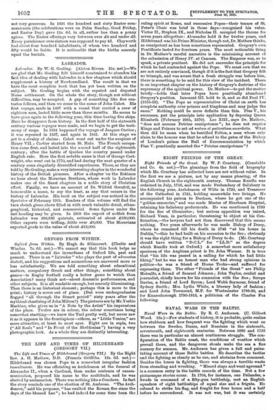• CURRENT LITERATURE.
THE RECTOR'S BOOK OF CLAYWORTH, NOTTS.
The Rector's Book of Clayworth, Notts. Transcribed and Edited by Harry Gill and Everard L. Guilford, M.A. (H. B. Saxton, Nottingham. 10.. 6d. net.)—On July 29th, 1672, William Sampson was presented to the benefice of Clayworth; he was instituted on the 31st, inducted on August 10th, and read himself in the next day,—they seem to have lost no time in those days. Two months later the Master of Pembroke Hall, to whose resignation he owed his preferment, made him President of that College. This necessitated a non-residence of three years. Accordingly we find under date " Nov. 27th, 75," the entry : "I came over to reside." On March 27th, 1676, he procured a book of vellum which was to serve as a record of all notable events concerning the parish and the benefice, births, marriages, deaths, briefs, income, "remark- able instances of God's Providence," and so forth. He hoped that his successors would continue the record. This they have not done, but we can at least be thankful that the book survives, for it is full of curiosities, or what two centuries and a half have made curiosities. There is the income, for instance, collected in those days in kind, now con- sisting of an unromantic tithe-rent charge. The old system had the merit or demerit of being highly speculative. The rector's best year was 1698, when he cleared 4246 Os. 4d. ; his worst 1688, when the income fell to 4109 8s. 91d. This year his tithe included twenty-two quarters of wheat at 20s., and forty-four of barley at 15s. In 1698 the figures were thirty-two of wheat at 42, and fifty-six of barley at 41 7s. 6d. One constant drawback was the disputing with the farmers. The rector was a stickler for his rights. He even exacted a farthing in the shilling from the labourers' wages,—it was paid, however, by tho farmer. But after two years' trial the charge was dropped. Church-rate and Poor- rate came together to about 415. But if rates wore not very high, taxes were. Sometimes these were of a strange kind. In 1694 a tax of 4s. was put on every burial ; if the person buried was a Doctor of Law, Physic, or Divinity, 45 extra had to be paid. Rector Sampson records having paid it when his elder brother, a London physician—he had held a benefice in the Commonwealth time—came down to see him and died four days afterwards. In almost every year there are entries of sundry " briefs," collections made throughout the kingdom for various objects. In 1692 7s. is collected for a fire at Havant, 2s. 74d. for another at Header; in Holderness, 5s. 6d. for sufferers by shipwreck, and 41 3s. 8d. for redemption of captives at Algiers. In 1686 the " Protestants fled out of France " get 42 12s. 6d. (possibly the fact of a Papist King opened the purse-strings). In 1689 the Irish Protestants get .17s. 5d., and 12s. 7d. in 1690. But the Clayworth people were not very generous. In 1691 the hundred and sixty Easter com- municants (the celebrations were on Palm Sunday, Good Friday, and Easter Day) gave lls. 6d. in all, rather less than a penny apiece. The Easter offerings vary between over £4 and under £3. Every parishioner over sixteen was supposed to pay 4cl. Clayworth had about four hundred inhabitants, of whom two hundred and fifty would be liable. It is noticeable that the births scarcely equal the burials.























































 Previous page
Previous page